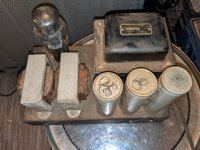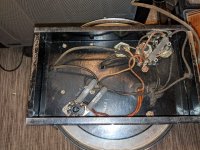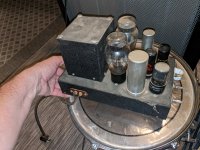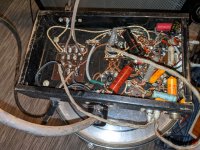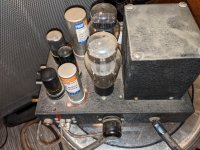I picked up three consoles on the weekend because the person wanted them out of the house to get ready to sell.
A westinghouse ra-509 "belvedere" and a westinghouse 823 and the last console had no name, It was quite old.
So in the Belvedere cabinet were the two pieces pictured below, along with the ra-509 tuner. It appears these were added to this unit.
The amp has no name but has some Canadian Hammond iron. The power tubes in push pull are 6a5g's and there is a 6sn7 and a few other tubes as you can see. The power transformer made by merit and is 800vct 200ma. The output is a Hammond 1715 PP 5k Can anyone ID this amp?
A westinghouse ra-509 "belvedere" and a westinghouse 823 and the last console had no name, It was quite old.
So in the Belvedere cabinet were the two pieces pictured below, along with the ra-509 tuner. It appears these were added to this unit.
The amp has no name but has some Canadian Hammond iron. The power tubes in push pull are 6a5g's and there is a 6sn7 and a few other tubes as you can see. The power transformer made by merit and is 800vct 200ma. The output is a Hammond 1715 PP 5k Can anyone ID this amp?
Attachments
Last edited:
I'm going to suggest it's a homebrew amp. Looks competently built, but taped off leads and other details point to a non-commercial product. There were a lot of 6B4G/6A5G circuits published in hobbyist magazines in the 40's. Might be a Brooke clone or something similar. What are the other tubes in the amp? Looks like some pentodes, maybe a 6SJ7? It might be possible to track down the circuit from an old radio/TV add or a popular electronics manual based on the tube compliment.
ETA: I see a 6SC7, which was a high-gain dual triode with special shielding. What's the other metal tube?
ETA: I see a 6SC7, which was a high-gain dual triode with special shielding. What's the other metal tube?
I see a 6SC7, which was a high-gain dual triode with special shielding. What's the other metal tube?
Hey grover, that would be a 6n7 and yes a 6sc7, 2 6a5g and one 5as4 rectifier.
That OPT is a bit too fancy for a common or garden PA amp. My guess is an audio amplifier used in conjunction with a film projector, or from an old jukebox. Is there anything that looks like it took the input from a photo voltaic tube? How are the exterior connections labelled and connected inside?
The 1715 output transformer is rated:
15 watts; 5k primary imp; output taps of 4, 8, 15, 30, 125, 250, 500; freq. resp. of 30 - 12k + - 1 db at full rated output. This from Hammonds 1965 catalog.
15 watts; 5k primary imp; output taps of 4, 8, 15, 30, 125, 250, 500; freq. resp. of 30 - 12k + - 1 db at full rated output. This from Hammonds 1965 catalog.
@OldHector ,There is no ID of any kind on the on the chassis. There is an umbilical octal connection and 3 pots. I have not analyzed the circuit yet. I was able to find another 1715 on the net so i purchased it, seeing as how this one was free. I just had to haul them away in my trailer. So many people don't bother with old consoles when there relatives pass on. It was a very unusual find. Usually free consoles are limited to single ended el84 and mono 6v6 PP amps.
@grover, I looked into the brook amp and that was an interesting bit of time spent. I'm going to map out the circuit soon. I have not had time.
@grover, I looked into the brook amp and that was an interesting bit of time spent. I'm going to map out the circuit soon. I have not had time.
The tube compliment is very similar to a Von Skoyoc phase-splitter, with the 6N7 acting as a long-tail pair driver, perhaps. That would be unusual but it might be what the original builder used.
https://www.audiofaidate.org/it/articoli/phase_compressor.pdf
Or it could be something simpler. ;-) It will be interesting to see if you can trace out the circuit.
https://www.audiofaidate.org/it/articoli/phase_compressor.pdf
Or it could be something simpler. ;-) It will be interesting to see if you can trace out the circuit.
Chassis like that, and tap-lists like that, were fairly common in 1940s and 1950s. Was it Stancor? made a line of chassis prepunched for any number of tubes, and sold separate dials for controls. Local radio/TV repairmen made custom gear for schools, churches, rich people. Find the archive of the first 5 years of AUDIO magazine, there's several custom rigs in those issues, as well as love for the big power triode.
This amp is on the shelf for a bit. I did order a matching OPT from a guy on the net.
Does anyone have any new circuit recommendations ? I will be looking for a nice simple cathode bias circuit.
As Prairieboy said
Does anyone have any new circuit recommendations ? I will be looking for a nice simple cathode bias circuit.
As Prairieboy said
The 6a5g is not a dht so that makes thing a bit simpler. I've not tried them before and honestly was not aware of this tube until I took ownership of this amp.The 1715 output transformer is rated:
15 watts; 5k primary imp; output taps of 4, 8, 15, 30, 125, 250, 500; freq. resp. of 30 - 12k + - 1 db at full rated output. This from Hammonds 1965 catalog.
This amp is on the shelf for a bit. I did order a matching OPT from a guy on the net.
Does anyone have any new circuit recommendations ? I will be looking for a nice simple cathode bias circuit.
As Prairieboy said
The 6a5g is not a dht so that makes thing a bit simpler. I've not tried them before and honestly was not aware of this tube until I took ownership of this amp.
6A5G is a great tube. Here's a very simple circuit.
https://darklanternforowen.wordpress.com/2014/06/15/2a3-push-pull-amplifier/
Scroll down to see the PP design. I've tried it and it sounds lovely. Substitute 6A5G for the 2A3. Use a single 6.3vac supply. Don't ground it but run the 400 ohm cathode resistor and bypass cap from the center tap. This will bias the the output tubes and also float the other filaments at 56vdc, which is perfect.
I would ignore the changes in green and build it as originally indicated. You can substitute a 6P5GT or 6J5GT for the 76 if you like. And you can use the feedback or not, there's not that much.
It doesn't get much simpler than this!
I believe it's out of an early electric organ. Could be Hammond or Allen. I bought a tube amp similar physical size a few years ago that is dual channel and I have all the bits to turn it into a sweet (I hope) audio amp. Mine's a Webster amp from an Allen organ. I was fortunate enough to track down a schematic via the organ company. Yours looks like a mono unit but it's not conclusive.
Regards Johnno
Regards Johnno
- Home
- Amplifiers
- Tubes / Valves
- Can you identify this old tube amp?
